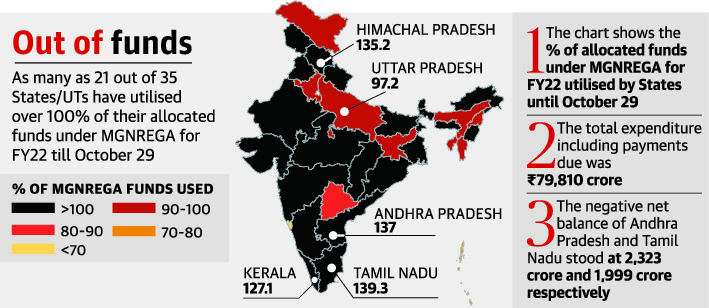Social Justice
Dearth of Funds in MGNREGA
- 30 Oct 2021
- 5 min read
Why in News
The Centre’s flagship rural employment scheme (MGNREGA) has run out of funds halfway through the financial year. This means that payments for MGNREGA workers as well as material costs will be delayed, unless the States dip into their own funds.
- Earlier, the government introduced the category-wise wage payment system for SC, ST and others, as made applicable from this current financial year (2021-22), to accurately reflect on the ground flow of funds to various population groups.
Key Points
- MGNREGA Scheme:
- The Mahatma Gandhi National Rural Employment Guarantee Act, earlier known as the National Rural Employment Guarantee Act was passed in 2005 to augment employment generation and social security in India.
- The scheme is a demand-driven wage employment scheme, which functions under the Ministry of Rural Development.
- Every adult member of a household in a rural area with a job card is eligible for a job under the scheme.
- The scheme envisages providing 100 days of guaranteed wage employment in a financial year to adult member volunteers for unskilled manual work.
- It covers all districts of India except the ones with 100% urban population.
- There is also a provision for additional 50 days of unskilled wage employment in drought/natural calamity notified rural areas.
- As per Section 3(4) of the MGNREGA, the States may make provisions for providing additional days beyond the period guaranteed under the Act from their own funds.
- Issues with MGNREGA:
- Ridiculously Low Wage Rate:
- Currently, the MNREGA wage rates of at least 17 of the 21 major states are even lower than the state minimum wage for agriculture. The shortfall is in the range of 2-33% of the minimum wage.
- The National Sample Survey Office (NSSO), 2017 data shows that the average daily wage for general agricultural labourers is Rs. 264.05 for men, and Rs. 205.32 for women.
- The ridiculously low wage rates have resulted in lack of interest among workers in working for MGNREGA schemes, making way for contractors and middle men to take control locally.
- Inadequate Financing:
- Due to lack of funds, state governments find it difficult to meet the demand for employment under MGNREGA.
- Delay in Payment of Wages:
- Most states have failed to disburse wages within 15 days as mandated by MGNREGA. In addition, workers are not compensated for a delay in payment of wages.
- This has turned the scheme into a supply-based programme and subsequently, workers had begun to lose interest in working under it.
- A 2016 judgement of the Supreme Court described pending wage payments under MGNREGA as “a clear constitutional breach committed by the State” and “a modern form of begar”.
- Most states have failed to disburse wages within 15 days as mandated by MGNREGA. In addition, workers are not compensated for a delay in payment of wages.
- Ineffective Role of PRI:
- With very little autonomy, gram panchayats are not able to implement this act in an effective and efficient manner.
- Large Number of Incomplete works:
- There has been a delay in the completion of works under MGNREGA and inspection of projects has been irregular. Also, there is an issue of quality of work and asset creation under MGNREGA.
- Fabrication of Job cards:
- There are several issues related to the existence of fake job cards, the inclusion of fictitious names, missing entries and delays in making entries in job cards.
- Ridiculously Low Wage Rate:
Way Forward
- Must Ensure Work is Provided:
- The government must ensure that work is provided notwithstanding the demand.
- The government should expand the scheme and focus on value addition and multiply community asset works.
- Strengthening the Scheme:
- There is a need for better coordination between various government departments and the mechanism to allot and measure the work.
- This is one of the best welfare schemes in recent years and it has helped the rural poor. However, government officials must take the initiative to implement the scheme and must not block the work.
- Gender Wage Gap:
- Some discrepancies in the payouts need to be addressed, too. Women in the sector, on an average, earn 22.24% less than their male counterparts.





